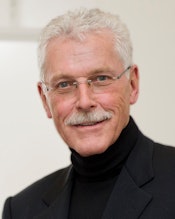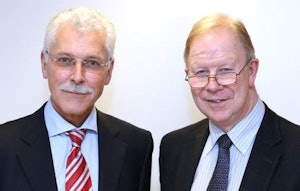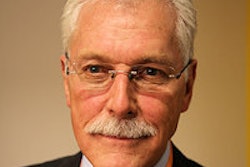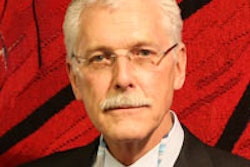
Dr. Maximilian Reiser is set to become the new editor in chief of European Radiology (ER) in January 2014. Despite the long lead-in time, he is already preparing for this challenging role, and is developing his own ideas for the journal's future.
More so now than ever, it is essential for journals to reinforce the scientific integrity and accuracy of their papers, yet continue to ensure readability, according to Reiser, who is director of clinical radiology at Ludwig Maximilian University in Munich and former president of the ECR and European Society of Radiology (ESR).
 After 15 years as editor in chief of Der Radiologe, Dr. Maximilian Reiser will be relinquishing the post to concentrate on European Radiology.
After 15 years as editor in chief of Der Radiologe, Dr. Maximilian Reiser will be relinquishing the post to concentrate on European Radiology.
"It's a fine balance. Some of the most prominent challenges right now apply to a range of journals, not just ER. These include legal issues, conflict of interest disclosures, sponsorship statements, statistical validity, and plagiarism, which have become major topics," he told AuntMinnieEurope.com. "ER is the flagship of radiological research in Europe, so all the prerequisites and attention to the scientific detail need to be fulfilled, but it is also important that the journal is engaging and retains the reader's interest."
With a view to further enhancing the readability of the journal, Reiser would like to provide the option of viewing content in a more concise way, enabling readers to more readily select the material they wish to expand upon in depth. His aim is to provide information on the most essential aspects of the papers in a more compact way to aid a reader's choice of material.
Also, he wants both online and print versions to appeal to a broader spectrum of readers. He thinks ER needs to appeal to policymakers, payors, and other decision-makers, in addition to the significant cadre of scientists and practicing radiologists who have supported the journal for many years.
Another priority is to build upon methods to alert ESR members to new research and, in particular, to easily identify groundbreaking innovations of wide relevance. As an academic, as well as a clinician and editor, Reiser is all too familiar with the pressure on scientists and their institutions to publish in reputable journals.
When asked how he compared ER to the European Journal of Radiology, Reiser pointed out that there was enough room for more than one journal.
"ER has an acceptance rate of 15%, and the journal regrets not being able to publish more papers," he said. "However, the academic community has a need to publish. As dean of a medical faculty, I realize the importance of publishing and being scientifically active, so we need more than one radiology English-language journal in Europe."
Regarding the breadth and depth of content, Reiser acknowledged that the journal needs to reflect its increasingly diverse readership. Subscribers of ER include specialists, subspecialists, and general radiologists, as well as scientists connected to radiology who may be interested in specific articles, he said, adding that this reinforces his point about developing methods and means of facilitating selection of material for readers.
ER has a long established record of strong scientific content, but some topics deserve more extensive coverage, according to Reiser. He noted the dichotomy of expectations that today's radiologist has for a journal.
"On the one hand, we need more basic science for future developments in imaging, but on the other, patient outcomes are more important than minor technical developments," he said, suggesting that ER might feature more articles on health economics and outcomes research, as well as content that takes an epidemiological view on the importance of diagnostics and interventions on patient outcomes, population health, and finances. "This is something I would like to promote if possible in the journal."
He highlighted that a wider range of articles would influence the journal's impact factor, which is of growing importance, particularly in Europe.
"We need to remember that impact also includes how articles are regarded by key decision-makers and the impact in relation to other disciplines," Reiser said. "Increasingly, I see articles cited which relate to the impact on patient outcomes and on the healthcare system. These are the aspects that our colleagues in related disciplines and decision-makers in policy, health insurance, and payors are keen to read."
 |
| Dr. Adrian Dixon's last edition of ER will be published in December 2013. He will continue as emeritus professor of radiology at the University of Cambridge and master of Peterhouse College. Image courtesy of the European Society of Radiology. |
Reiser will replace Dr. Adrian Dixon, from Cambridge, U.K., as editor in chief from January 2014. "Professor Dixon has done a wonderful job; it's a hard act to follow, so I hope I can!" Reiser acknowledged.
Reiser is an experienced editor with 15 years of experience as editor in chief of Der Radiologe, a German-language general radiology journal published by Springer, which also publishes ER. Once his replacement on Der Radiologe has been appointed, Reiser will leave this post in order to concentrate on ER. A new editor for Der Radiologe should be appointed by this autumn at the latest.
At present, Reiser is dean of the medical faculty at Ludwig Maximilian University, and he still conducts radiological examinations and interventions, but he acknowledges that he is reviewing his various commitments in view of his new position at ER. "I need to carefully consider which roles I can continue with and which I have to surrender to take on the task of editor of ER."
With Dixon's help, he is familiarizing himself with the challenges that lie ahead. He said ER is already one of Europe's leading specialist journals, but with the growth in online readership, he believed there was scope to further develop the electronic edition. Electronic access to ER costs ESR members only 10 euros per year, and this is set to continue. The readership is extensive because the ESR has a membership of 52,000, all of whom have access, and ER currently has approximately 500,000 downloads per year. Reiser noted that the electronic version had more readers than the print edition these days, hence the importance of targeting resources at the online version.
"Around 75% of readers of the electronic version find the journal through search engines and indexing pages, via a search relating to a clinical problem or term, which then directs the reader to ER's website," he said.



















